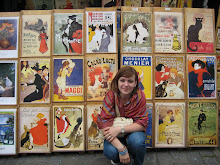Spain: Episode Malaga
As I wrote to my friends in the IC group, Malaga was a short, half a day stop. This is a city just relatively recently turned famous, which is the home of:
...Bruna, my friend from IC, who is studying there and who just found out she was accepted in the MC of Ireland. :)
 ...Picasso. It hosts the museum of Picasso as well as some temporary expositions like the art collection of Pierre Matisse, the son of Henry Matisse, the famous painter.
...Picasso. It hosts the museum of Picasso as well as some temporary expositions like the art collection of Pierre Matisse, the son of Henry Matisse, the famous painter. Antonio Banderas was also born here. And he has his signature in the famous El Pimpi bar, next to those of Tony Blair and Paloma Picasso.
Antonio Banderas was also born here. And he has his signature in the famous El Pimpi bar, next to those of Tony Blair and Paloma Picasso. Malaga has a very nice commercial area, that was dressed in festive clothes at the time I was there. This was because people were getting ready for the Semana Santa or Holly Week, which is one week before Easter.
Malaga has a very nice commercial area, that was dressed in festive clothes at the time I was there. This was because people were getting ready for the Semana Santa or Holly Week, which is one week before Easter. ...you cannot see, but there are chairs out in the street witing for people who paid to see the processions that take place during this week. Every day a statue (called Passo or Trono) like the one below is carried on the shoulders by people who pay to do it. And if it rains, the statues cannot come out, so people who paid to carry them are left without their investment or the honour. :)
...you cannot see, but there are chairs out in the street witing for people who paid to see the processions that take place during this week. Every day a statue (called Passo or Trono) like the one below is carried on the shoulders by people who pay to do it. And if it rains, the statues cannot come out, so people who paid to carry them are left without their investment or the honour. :)Ana tells me it's a very impressive thing to see and that the music that accompanies them- which is funeral music- is quite hard to take.
 Malaga also has a mini-fortress called Alcazaba...
Malaga also has a mini-fortress called Alcazaba... ...with an old Roman theatre, built in the 11th century. It was ordered by a king of Granada.
...with an old Roman theatre, built in the 11th century. It was ordered by a king of Granada. One can also see the port and of course lye on the sunny beaches.
One can also see the port and of course lye on the sunny beaches. No Spanish city is complete without...a catherdral.
No Spanish city is complete without...a catherdral. ...and nice squares.
...and nice squares. At the end of the day I had a blast with Ana and her friend. We went to a live music concert with this great band that was playing covers... Older fellas, but with a lot of charisma and energy to make a real show and keep us singing and dancing with every song. The biggest victory of the night was to take a picture with them, especially the guy below who was the best looking in the pack. :P
At the end of the day I had a blast with Ana and her friend. We went to a live music concert with this great band that was playing covers... Older fellas, but with a lot of charisma and energy to make a real show and keep us singing and dancing with every song. The biggest victory of the night was to take a picture with them, especially the guy below who was the best looking in the pack. :P ...and boy did we get wild that night. After all..it was our night...and girls just wanted to have fun. :)
...and boy did we get wild that night. After all..it was our night...and girls just wanted to have fun. :)































